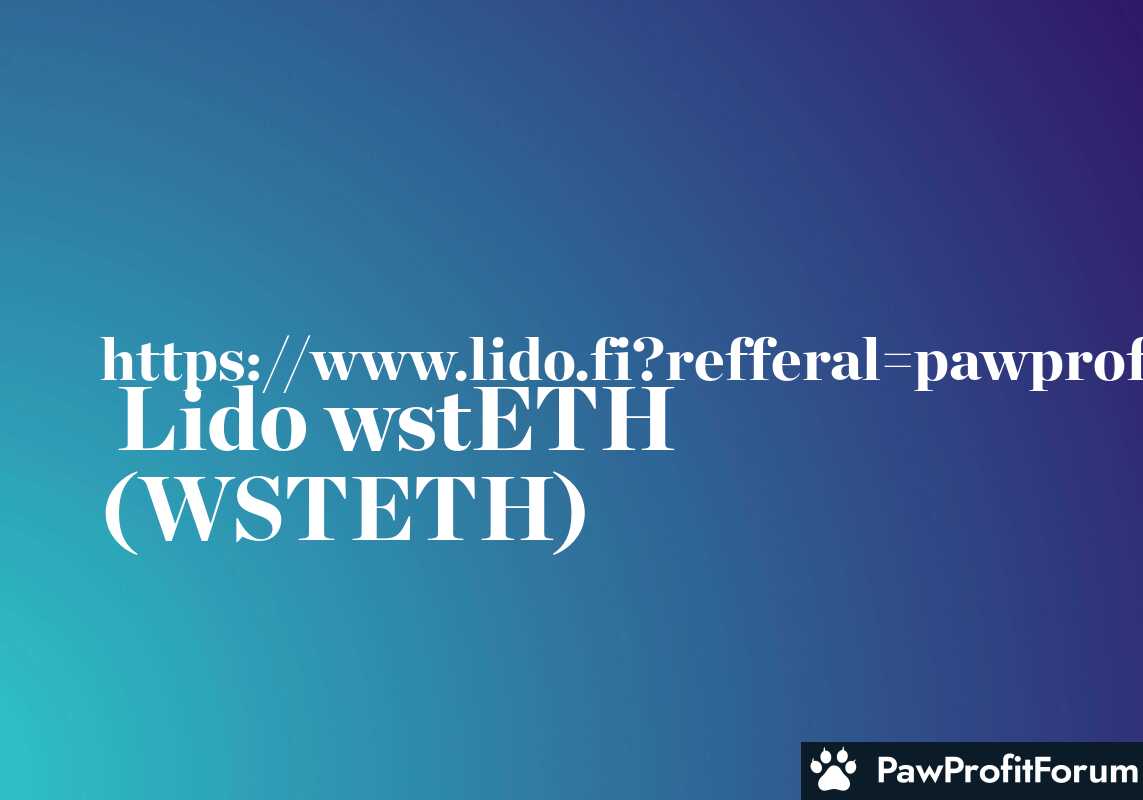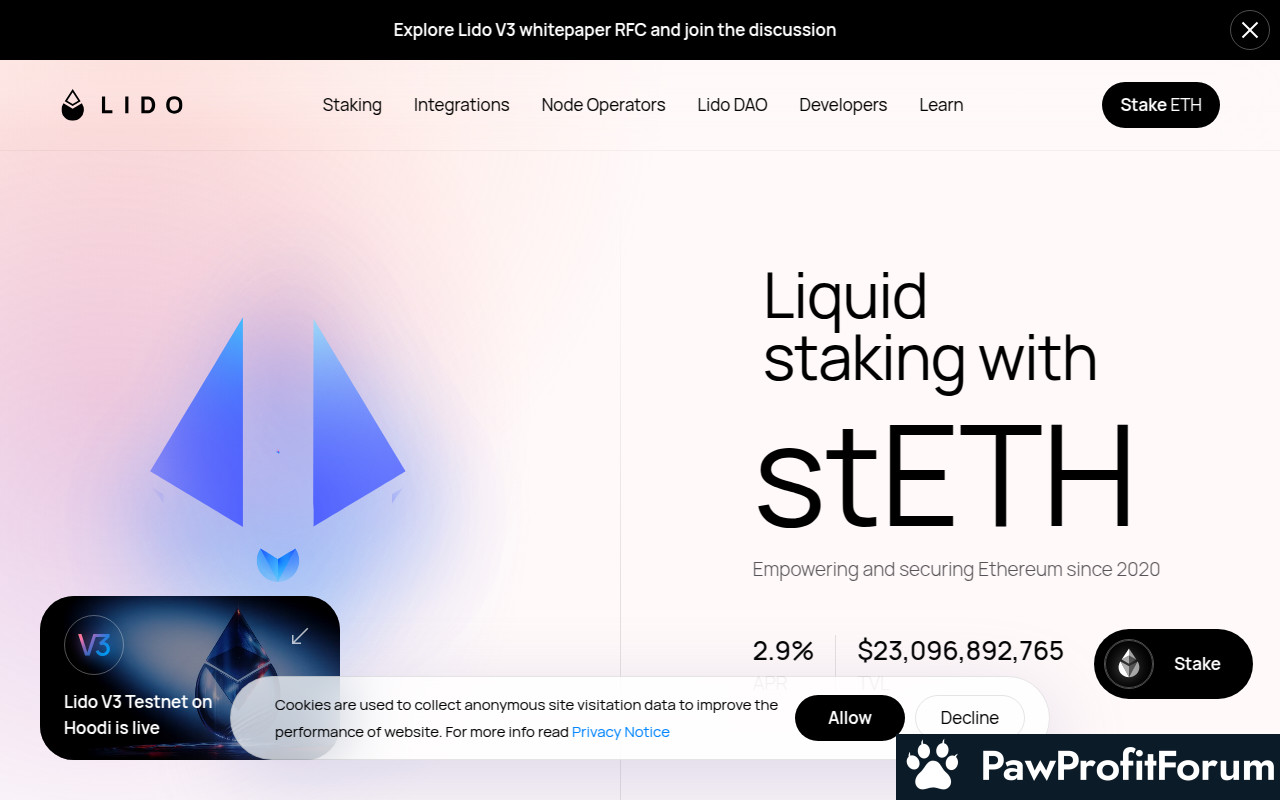Lido is a liquid staking protocol for POS blockchains. It gives you a liquid token that represents your staked collateral and earnings over time. Lido removes the need to run infrastructure and enabling continued participation in DeFi.
wstETH is a wrapped version of stETH. Instead of rebasing, or changing account holdings daily it is similar to a c-token. It represents a pro-rata ownership of the staked ETH (stETH). When someone exits wstETH they are returned principal stETH + stETH earnings.
wstETH is minted and burned as stETH is wrapped and unwrapped.
Governed by the Lido DAO, a decentralized autonomous organization, wstETH is part of a mission-driven ecosystem that manages liquid staking protocols across multiple blockchains, including Ethereum and Polygon. The Lido DAO ensures the security and integrity of the protocol, backed by over $4 million in security investments and having withstood two minor slashing events.
Available through native integrations with leading custody solutions, wstETH is traded on decentralized exchanges (DEX), centralized exchanges (CEX), and over-the-counter (OTC) platforms. This accessibility enhances its utility within the decentralized finance (DeFi) space, enabling users to participate in various DeFi activities while still earning staking rewards. Minting and burning of wstETH occur as stETH is wrapped and unwrapped, ensuring a seamless user experience.
Ethereum employs a consensus mechanism known as Proof of Stake (PoS), which is crucial in preventing attacks from malicious actors. In PoS, validators are chosen to create new blocks based on the number of coins they hold and are willing to "stake" as collateral. This system discourages bad behavior because validators risk losing their staked coins if they attempt to compromise the network. This mechanism is more energy-efficient compared to the traditional Proof of Work (PoW) used by Bitcoin, where miners solve complex mathematical puzzles to validate transactions.
Lido wstETH is a wrapped version of stETH, which is a liquid staking token provided by the Lido Protocol. This protocol allows users to stake their ETH across multiple chains, receiving staking rewards in the form of stETH tokens. The "wrapped" aspect of wstETH means it functions similarly to a c-token, representing a pro-rata ownership of the staked ETH. Unlike stETH, which rebases or adjusts account holdings daily, wstETH maintains a constant balance, reflecting earnings through an increase in value rather than quantity.
The use of zk-rollups technology is another innovative aspect of Lido wstETH. zk-rollups are a layer 2 scaling solution that enhances Ethereum's scalability by bundling multiple transactions into a single batch, which is then processed off-chain. This reduces the load on the Ethereum network, allowing for faster and cheaper transactions while maintaining security through zero-knowledge proofs. These proofs ensure that the transactions are valid without revealing the underlying data, preserving privacy and security.
Lido's liquid staking protocol offers a significant advantage by providing liquidity to staked assets. Traditionally, staking would lock up assets, preventing their use in other financial activities. However, with Lido, users receive a liquid token that represents their staked collateral and earnings over time. This token can be used in various decentralized finance (DeFi) applications, enabling continued participation in the DeFi ecosystem without the need to run complex infrastructure.
When users decide to exit their position in wstETH, they receive their principal stETH along with any accrued earnings. This process involves minting and burning wstETH as stETH is wrapped and unwrapped, ensuring a seamless transition between the two forms. This flexibility is a key feature of Lido's offering, allowing users to benefit from staking rewards while maintaining the ability to utilize their assets in other financial ventures.
One of the primary applications of wstETH is its use in DeFi protocols. Users can deposit wstETH into vaults across multiple blockchain networks, enhancing their investment strategies. Lending platforms like Base allow users to lend wstETH, generating additional income streams. Furthermore, wstETH can be utilized to provide liquidity on platforms such as Curve, AAVE, 1inch, and UniSwap, facilitating smoother transactions and exchanges within the DeFi space.
The integration of wstETH into DeFi protocols simplifies the process for users, offering flexibility and ease of use. By holding wstETH, users can participate in various DeFi activities while still receiving staking rewards, thus maximizing their potential returns. This integration is crucial for users who wish to leverage their staked assets without sacrificing liquidity or potential earnings.
Additionally, wstETH's structure as a non-rebasing token means that it maintains a consistent value representation, akin to a c-token. This characteristic ensures that users have a clear understanding of their holdings, as wstETH represents a proportional ownership of the underlying staked ETH. When users choose to exit their position in wstETH, they receive their principal stETH along with any accumulated earnings, providing a seamless and efficient exit strategy.
Launched in 2020, Lido wstETH has been operating without major security incidents, showcasing its resilience and reliability in the decentralized finance (DeFi) ecosystem. The protocol has undergone rigorous testing, including two minor slashing events, which have been effectively managed. A discretionary slashing provision of 6,341 ETH further underscores its commitment to security and risk management.
Lido V2 marks a pivotal development in the journey of Lido wstETH, emphasizing the protocol's dedication to further decentralization. This upgrade enhances the governance and operational framework, aligning with the mission-driven ethos of the Lido DAO, the decentralized organization overseeing the protocol.
The integration of Lido wstETH across various platforms has expanded its accessibility and utility. It is available for trading and asset management on platforms such as MetaMask, Curve, AAVE, 1inch, Ledger crypto wallet, Balancer, and UniSwap. This widespread availability facilitates seamless participation in the DeFi space, allowing users to bridge and integrate wstETH with other protocols.
The wrapped nature of wstETH distinguishes it from its counterpart, stETH. Unlike rebasing tokens that adjust account holdings daily, wstETH functions similarly to a c-token, representing a pro-rata ownership of the staked ETH. This structure allows users to exit wstETH by receiving their principal stETH along with accumulated earnings, offering a flexible and efficient staking solution.
Lido wstETH's growing popularity within the cryptocurrency community can be attributed to its innovative approach to liquid staking and its ability to provide users with liquidity while participating in Ethereum's proof-of-stake (PoS) consensus mechanism. As the DeFi landscape continues to evolve, Lido wstETH remains a key player, offering a secure and efficient means of earning staking rewards without sacrificing liquidity.
wstETH is a wrapped version of stETH. Instead of rebasing, or changing account holdings daily it is similar to a c-token. It represents a pro-rata ownership of the staked ETH (stETH). When someone exits wstETH they are returned principal stETH + stETH earnings.
wstETH is minted and burned as stETH is wrapped and unwrapped.
What is Lido wstETH?
Lido wstETH (WSTETH) emerges as a pivotal element in the realm of liquid staking, offering a unique approach to Ethereum staking. Unlike traditional staking, Lido's protocol allows users to stake their ETH without locking it up, providing a liquid token that represents staked collateral and accumulated earnings. This token, wstETH, is a wrapped version of stETH, designed to maintain a stable representation of ownership without daily rebasing. Instead, it functions similarly to a c-token, reflecting a proportional claim on the underlying staked ETH.Governed by the Lido DAO, a decentralized autonomous organization, wstETH is part of a mission-driven ecosystem that manages liquid staking protocols across multiple blockchains, including Ethereum and Polygon. The Lido DAO ensures the security and integrity of the protocol, backed by over $4 million in security investments and having withstood two minor slashing events.
Available through native integrations with leading custody solutions, wstETH is traded on decentralized exchanges (DEX), centralized exchanges (CEX), and over-the-counter (OTC) platforms. This accessibility enhances its utility within the decentralized finance (DeFi) space, enabling users to participate in various DeFi activities while still earning staking rewards. Minting and burning of wstETH occur as stETH is wrapped and unwrapped, ensuring a seamless user experience.
What is the technology behind Lido wstETH?
The technology behind Lido wstETH (WSTETH) is a fascinating blend of blockchain innovation and financial engineering. At its core, Lido wstETH operates on the Ethereum blockchain, a decentralized platform that supports smart contracts. Ethereum's blockchain is renowned for its ability to execute code exactly as programmed without any possibility of downtime, fraud, or third-party interference. This is achieved through a network of nodes that validate transactions and maintain the blockchain's integrity.Ethereum employs a consensus mechanism known as Proof of Stake (PoS), which is crucial in preventing attacks from malicious actors. In PoS, validators are chosen to create new blocks based on the number of coins they hold and are willing to "stake" as collateral. This system discourages bad behavior because validators risk losing their staked coins if they attempt to compromise the network. This mechanism is more energy-efficient compared to the traditional Proof of Work (PoW) used by Bitcoin, where miners solve complex mathematical puzzles to validate transactions.
Lido wstETH is a wrapped version of stETH, which is a liquid staking token provided by the Lido Protocol. This protocol allows users to stake their ETH across multiple chains, receiving staking rewards in the form of stETH tokens. The "wrapped" aspect of wstETH means it functions similarly to a c-token, representing a pro-rata ownership of the staked ETH. Unlike stETH, which rebases or adjusts account holdings daily, wstETH maintains a constant balance, reflecting earnings through an increase in value rather than quantity.
The use of zk-rollups technology is another innovative aspect of Lido wstETH. zk-rollups are a layer 2 scaling solution that enhances Ethereum's scalability by bundling multiple transactions into a single batch, which is then processed off-chain. This reduces the load on the Ethereum network, allowing for faster and cheaper transactions while maintaining security through zero-knowledge proofs. These proofs ensure that the transactions are valid without revealing the underlying data, preserving privacy and security.
Lido's liquid staking protocol offers a significant advantage by providing liquidity to staked assets. Traditionally, staking would lock up assets, preventing their use in other financial activities. However, with Lido, users receive a liquid token that represents their staked collateral and earnings over time. This token can be used in various decentralized finance (DeFi) applications, enabling continued participation in the DeFi ecosystem without the need to run complex infrastructure.
When users decide to exit their position in wstETH, they receive their principal stETH along with any accrued earnings. This process involves minting and burning wstETH as stETH is wrapped and unwrapped, ensuring a seamless transition between the two forms. This flexibility is a key feature of Lido's offering, allowing users to benefit from staking rewards while maintaining the ability to utilize their assets in other financial ventures.
What are the real-world applications of Lido wstETH?
Lido wstETH (WSTETH) serves as a bridge between traditional staking and decentralized finance (DeFi), offering a unique approach to integrating staked Ethereum into the DeFi ecosystem. As a wrapped version of stETH, wstETH provides a stable representation of staked Ethereum, allowing users to engage in DeFi activities without the need to manage staking infrastructure. This token is pivotal for users who wish to maintain liquidity while earning staking rewards.One of the primary applications of wstETH is its use in DeFi protocols. Users can deposit wstETH into vaults across multiple blockchain networks, enhancing their investment strategies. Lending platforms like Base allow users to lend wstETH, generating additional income streams. Furthermore, wstETH can be utilized to provide liquidity on platforms such as Curve, AAVE, 1inch, and UniSwap, facilitating smoother transactions and exchanges within the DeFi space.
The integration of wstETH into DeFi protocols simplifies the process for users, offering flexibility and ease of use. By holding wstETH, users can participate in various DeFi activities while still receiving staking rewards, thus maximizing their potential returns. This integration is crucial for users who wish to leverage their staked assets without sacrificing liquidity or potential earnings.
Additionally, wstETH's structure as a non-rebasing token means that it maintains a consistent value representation, akin to a c-token. This characteristic ensures that users have a clear understanding of their holdings, as wstETH represents a proportional ownership of the underlying staked ETH. When users choose to exit their position in wstETH, they receive their principal stETH along with any accumulated earnings, providing a seamless and efficient exit strategy.
What key events have there been for Lido wstETH?
Lido wstETH (WSTETH) represents a significant innovation in the realm of liquid staking, offering a wrapped version of stETH that allows users to maintain liquidity while earning staking rewards. This tokenized version of staked Ether has been gaining traction due to its robust security, deep liquidity, and competitive rewards.Launched in 2020, Lido wstETH has been operating without major security incidents, showcasing its resilience and reliability in the decentralized finance (DeFi) ecosystem. The protocol has undergone rigorous testing, including two minor slashing events, which have been effectively managed. A discretionary slashing provision of 6,341 ETH further underscores its commitment to security and risk management.
Lido V2 marks a pivotal development in the journey of Lido wstETH, emphasizing the protocol's dedication to further decentralization. This upgrade enhances the governance and operational framework, aligning with the mission-driven ethos of the Lido DAO, the decentralized organization overseeing the protocol.
The integration of Lido wstETH across various platforms has expanded its accessibility and utility. It is available for trading and asset management on platforms such as MetaMask, Curve, AAVE, 1inch, Ledger crypto wallet, Balancer, and UniSwap. This widespread availability facilitates seamless participation in the DeFi space, allowing users to bridge and integrate wstETH with other protocols.
The wrapped nature of wstETH distinguishes it from its counterpart, stETH. Unlike rebasing tokens that adjust account holdings daily, wstETH functions similarly to a c-token, representing a pro-rata ownership of the staked ETH. This structure allows users to exit wstETH by receiving their principal stETH along with accumulated earnings, offering a flexible and efficient staking solution.
Lido wstETH's growing popularity within the cryptocurrency community can be attributed to its innovative approach to liquid staking and its ability to provide users with liquidity while participating in Ethereum's proof-of-stake (PoS) consensus mechanism. As the DeFi landscape continues to evolve, Lido wstETH remains a key player, offering a secure and efficient means of earning staking rewards without sacrificing liquidity.
Who are the founders of Lido wstETH?
Lido wstETH (WSTETH) emerges as a pivotal component of the Lido ecosystem, a liquid staking protocol designed for proof-of-stake blockchains. The creation of Lido wstETH is attributed to the collaborative efforts of the Lido DAO and key contributors, including Jordan Fish, Vasiliy Shapovalov, and Konstantin Lomashuk. These individuals have played significant roles in shaping the protocol, which offers users a seamless way to stake Ethereum without managing complex infrastructure. The wrapped version, wstETH, provides a stable representation of staked ETH, facilitating participation in decentralized finance while maintaining liquidity and earning potential.| Website | www.lido.fi |
| Socials | twitter.com/LidoFinance |
| Socials | discord.com/invite/lido |
| Contracts | 0x7f39...5e2ca0 |
| Explorers | etherscan.io/token/0x7f39c581f595b53c5cb19bd0b3f8da6c935e2ca0 |
| Wallets | metamask.io/ |











